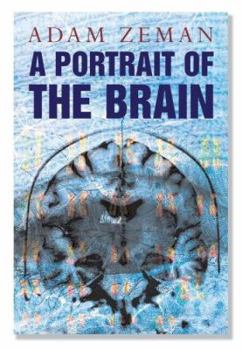A Portrait of the Brain
Select Format
Select Condition 
Book Overview
Bizarre, perplexing, and moving cases of brain disorder, told by a neurologist with an extraordinary gift for storytelling In this compelling book, neurologist Adam Zeman tells the stories of patients... This description may be from another edition of this product.
Format:Hardcover
Language:English
ISBN:0300114168
ISBN13:9780300114164
Release Date:April 2008
Publisher:Yale University Press
Length:246 Pages
Weight:0.70 lbs.
Dimensions:1.1" x 6.4" x 9.5"
Customer Reviews
2 ratings
A feast of knowledge
Published by Thriftbooks.com User , 15 years ago
A Portrait of the Brain, by Adam Zeman (Yale University Press, 2008) is (unusually) everything the blurb writers say it is: knowledgeable, beautifully organized, humane and well written. I have read it twice and plan to read it again. Zeman is Professor of Cognitive and Behavioural Neurology at Peninsula Medical School (The book doesn't say which peninsula! - clue: the author now lives in Exeter,SW England). Zeman takes us on a tour of the human brain, the most complex organism known to us, drawing on case studies to show what happens when any level goes wrong. The chapter headings whet the appetite - Chapter 1 Atom "I Am Tired" Chapter 2 Gene "Don't Fidget" Chapter 3 Protein "The Light of Dawn" Chapter 4 Organelle "Metamorphoses" Chapter 5 Neuron "Lost in Translation" Chapter 6 Synapse "Dr Gelineau's Dream" Chapter 7 Neural Network "The Sense of Pre-existence" Chapter 8 Lobe "The Art of Losing" Chapter 9 Psyche "Betrayal" Chapter 10 Soul "The Anatomy of the Soul" Epilogue "O Magnum Mysterium" Each level (Atom, Gene, etc) is illustrated by a diagram that works like a logo. The author draws widely and effectively on art, science and literature. Opening chapters cite Hippocrates, Joni Mitchell, John Harvey (1657), a Gaelic folk song, Ecclesiastes, Ivan Goncharov's Oblamov, Shakespeare and W.H. Auden, and make one want to visit or revisit Edinburgh's Dean Gallery and look at Paul Delvaux's painting, The Call of the Night. Zeman acknowledges his gratitude to the people whose humanity (sorrow, joy, cure and loss) shines through their "case study" stories. This book combines wonder at life with a profound awareness of mortality. Like pre-Hellenistic Christianity (and this reviewer), A Portrait of the Brain doesn't believe in a surviving "soul," but allows an open faith-door to resurrection. When we die, we perish, utterly. Anything "beyond" that is a gift, not a given.
A great book conveying scientific knowledge through tales
Published by Thriftbooks.com User , 16 years ago
It is a well written and organized book which provides fundamental knowledge about human brain and some associated neurological diseases. As a student with background out of neuroscience, I could finish reading the book without any difficulty. The book is organized in such a way that readers can gradually learn the fundamental knowledge of brain from one chapter after another to help them understand material in the later chapters. Therefore, readers may not necessarily have solid neuroscience or biological background to start the book. The book consists of ten chapters, each of which describes one level of human brain, from atom to gene, from protein to neuron, from neural network to lobe. In each chapter, the author talks about scientific exploration, discovery and identification of that specific level of physiological constitution of brain, through a tale of brain disorder related to that constitution. The author had very close contact with, in most case he was directly consulted by, people involved in those tales. Therefore, the stories he presented are vivid and discussed in details. For example, in chapter one, the author firstly reports a clinical case he had encountered, in which a female patient woke up with a headache and exhaustive feeling in the morning. Although this symptom was alleviated as hours went on, it slowly and surely got worse and worse day after day. The original cause was not identified by the author at that time. Then he started to discuss the fundamental element forming the universe - atom, which most of us have been familiar with. At a first glance, there is no direct relationship between atoms and the patient's problem. However, it turned out to be that the patient's strange symptom was due to the lack of oxygen in brain during sleep. After experiencing a severe coma in one morning, the patient was sent to hospital and diagnosed to have an uncommon muscle disorder, "multicore myopathy", which affected her diaphragm. This muscle is particularly important to us in sleep as gravity no longer keeps our abdominal organs in their place. If the diaphragm fails, breathing in sleep can fail too. This resulted in insufficient oxygen supplying to the brain and caused the headache as well as tiring symptom. Another chapter, which I personally was impressed with, is chapter 3 introducing protein. It conveys abundant information in a clear organized content and with easy to understand words. Protein as we all know is one of the fundamental substrates to our biology, forming internal structure of our cells, regulating the chemical reactions and as hormones or neurotransmitters. However, not everyone knows that the protein can be infectious and transmit disease from one brain to another. In this chapter, author describes the discovery and identification of a few strange and terrible diseases, including scrapies, kuru, BSE (bovine spongiform encephalopathy) and CJD (Creutzfelft-Jakob disease), which had occurred in sheep, cattle





